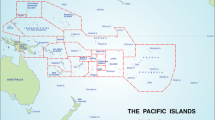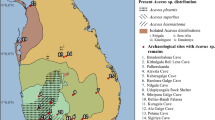Abstract
Thomas Lynch (1971) has recently attempted to document the fact that the preceramic hunter-gatherers of Peru were mobile throughout a range of altitudinal zones and that the fields of movement of these preceramic populations may well have been continuous, since the members of each group exploited the resources of different habitats in terms of regular annual cycles. However, it is equally clear that these long, linear fields of the preceramic populations began to be fragmented at some point in lime. We believe that the termination of the proposed period of transhumance constitutes an extremely interesting problem. At the present time this feature has been discussed only in terms of data from the Peruvian coast. In this paper we employ some of Lynch’s data and observations in an attempt to demonstrate (I) that a minimum of modification of the preceramic pattern of food procurement within the highlands was required to convert hunter-gatherers into food producers; and (2) wild tubers played a crucial role in this process.
Similar content being viewed by others
Literature Cited
Adovasio, James M. and T. F. Lynch 1973. “Preceramic Textiles and Cordage from Guitarrero Cave, Peru.”American Antiquity 38: 84–90.
Anonymous 1960.Index of Plant Diseases in the United States. U.S. Department of Agriculture Handbook No. 165. Washington, D.C.
Binford, Lewis R. 1968. “Post-Pleistocene Adaptations.” In:New Perspectives in Archaeology (ed. by S. Binford and L. Binford), pp. 313–341. Chicago: Aldine Publishing Company.
Bryan, A. L. 1965. “Paleo-American Prehistory.” Idaho State University Museum,Occasional Papers, No. 16. Pocatello.
— 1969. “Early Man in America and the Late Pleistocene Chronology of Western Canada and Alaska.”Current Anthropology 10:339–367.
Cardich, A. 1958. “Los Yacimientos de Lauricocha, Nuevas Interpretaciones de la Prehistoria Peruana.”Studia Praehistorica 1 (65 pp.) Buenos Aires.
-, 1964. “Lauricocha, Fundamentos papa una Prehistoria de los Andes Centrales.”Studia Praehistorica 3. Buenos Aires.
Carniero, Robert L. 1970. “A Theory of the Origin of the State.”Science 169: 733–738.
Casteel, Richard W. 1972. “Two Static Maximum Population-density Models for Hunter-Gatherers: A First Aproximation.”World Archaeology 4: 19–40.
Christianson, Gale 1972. “Population, the Potato and Depression in Ireland: 1800-1830.”Eire-Ireland 7(4): 70–95.
Connell, Kenneth 1950.The Population of Ireland,1750-1845. Oxford.
Crew, Harvey 1969. “A Lithic Analysis of Edgewear and Manufacturing Processes: A Chilean Case.” Unpublished Masters Thesis, University of California, Davis.
Dodds, K. S. 1965. “The History and Relationships of Cultivated Potatoes.” In:Essays on Crop Plant Evolution (ed. by Sir J. Hutchinson) pp. 123–141. London: Cambridge University Press.
Dumond, D. E. 1965. “Population Growth and Cultural Changes.”Southwestern Journal of Anthropology 21: 302–324.
Flannery, Kent V. 1968. “Archaeological Systems Theory and Early Mesoamerica.”In: Anthropology Archaeology in the Americas, (ed. by Betty J. Meggers) Anthropological Society of Washington, pp. 67–87.
Haggett, Peter 1965.Locational Analysis in Human Geography. New York: St. Martin’s.
Harner, Michael1970. “Population Pressure and the Social Evolution of Agriculturalists.”Southwestern Journal of Anthropology 26: 67–86.
Hawkes, J. G. 1941. “Potato Collecting Expeditions in Mexico and South America.“ImperialBureau of Plant Breeding and Genetics, School of Agriculture, Cambridge.
Izumi, S. and T. Sono 1963.Andes 2: Excavations at Kotosh, Peru, 1960. Tokyo: Kadokawa.
Jensen, Peter M. 1972. “High Altitude Adaptations in Andean South America.” University of California, Davis, Department of Anthropology,M.S.
Kreuzer, F. 1966. “Transport of Oxygen and Carbon Dioxide at Altitude.”In: Exercise at Altitude (ed. by R. Margaria). Amsterdam: Excerpa Medica Foundation.
Krieger, A. 1964. “Early Man in the New World.” In:Prehistoric Man in the New World (ed. by J. Jennings and E. Norbeck). pp. 23–81. Chicago: University of Chicago Press.
Lanning, E. P. 1965. “Early man in Peru.”Scientific American 213: 68–76.
— 1970. “Pleistocene Man in South America.”World Archaeology 2: 90–111.
Lathrop, Donald 1969. Review ofPeru Before the Incas. American Antiquity 38: 609, 619.
Lynch, Thomas F. 1967. “The Nature of the Central Andean Preceramic.” Idaho State University Museum,Occasional Papers, No. 21. Pocatello.
— 1971. “Preceramic Transhumance in the Callejon de Huaylas, Peru.”American Antiquity 36: 139–148.
MacNeish, R., A. Nelken-Terner and A. G. Cook 1970. “Second Annual Report of the Ayacucho Archaeological-Botanical Project.” Andover, Massachusetts:Robert S. Peabody Foundation for Archaeology.
Mishkin, B. 1946. “The Contemporary Quechua.”Bureau of American Ethnology, Smithsonian Institution, Bulletin 143,2: 411–470.
Murra, J. V. 1965. “Herds and Herders of the Inca State.” In:Man, Culture and Animals (ed. by A. Leads and A. Vayda). pp. 185–217. Washington: American Association for the Advancement of Science.
Patterson, T. C. 1971a. “The Emergence of Food-Production on the Peruvian Coast.” In:Prehistoric Agriculture (ed. by S. Struever). pp. 181–208. New York: Natural History Press.
— 1971b. “Central Peru: Its Population and Economy.”Archaeology 76: 316–321.
Patterson, T. C. and E. P. Lanning 1964. “Changing settlement Patterns on the Peruvian Coast.”Nawpa Pacha 2: 113–123.
Pikersgill, Barbara 1969. “The Archaeological Record of Chile Peppers(Capsicum spp.) and the Sequence of Plant Domestication in Peru.”American Antiquity 34: 54–61.
Pollard, Gordon 1971. “Cultural Change and Adaptation in the Central Atacama Desert of Northern Chile.”Nawpa Pacha 9: 41–64.
Rowe, John 1946. “Inca Culture at the Time of the Spanish Conquest.” In:Bureau of American Ethnology, Smithsonian Institution, Bulletin 143,2: 183–330.
Sanders, W. T. and B. Price 1968.Mesoamerica: The Evolution of a Civilization. New York: Random House.
Sauer, C. O. 1958. “Age and Area of American Cultivated Plants.”33rd International Congress of Americanists 1: 215–229.
Stouse, Pierre, Jr. 1970. “The Distribution of Llamas in Bolivia.”Proceedings of the Association of American Geographers 2:136–140.
Strong, W. D. and C. Evans 1952. “Cultural Stratigraphy of the Vim Valley, Northern Peru.”Columbia University Studies in Archaeology and Ethnology 4.
True, D. L. and Harvey Crew 1972. “Archaeological Investigations in Northern Chile.” University of California, Davis, Department of Anthropology,M.S.
Ugent, Donald 1970. “The Potato.”Science 170(3963): 1161–1166.
Willey, Gordon 1971.An Introduction to American Archaeology, Vol. 2: South America. Englewood-Cliffs, New Jersey: Prentice-Hall, Inc.
Wrigley, E. A. 1967. “Demographic Models and Geography.”In: Socio-Economic Models in Geography (ed. by R. Chorley and P. Haggett), pp. 189–216.
Zubrow, Ezra B. W. 1971. “Carrying Capacity and Dynamic Equilibrium in the Prehistoric Southwest.”American Antiquity 36: 127–138.
Author information
Authors and Affiliations
Additional information
This is a slight revision of a paper presented in a symposium entitled “Ecological Approaches” at the Southwestern Anthropological Association Annual Meeting, California State College at Long Beach, March 31,1972.
Rights and permissions
About this article
Cite this article
Jensen, P.M., Kautz, R.R. Preceramic transhumance and andean food production. Econ Bot 28, 43–55 (1974). https://doi.org/10.1007/BF02861378
Received:
Issue Date:
DOI: https://doi.org/10.1007/BF02861378




